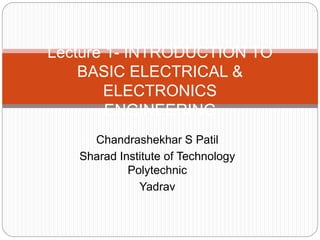
Lecture 1 bee
- 1. Chandrashekhar S Patil Sharad Institute of Technology Polytechnic Yadrav Lecture 1- INTRODUCTION TO BASIC ELECTRICAL & ELECTRONICS ENGINEERING
- 2. Subject Details PROGRAM NAME: MECHANICAL ENGINEERING AND AUTOMOBILE ENGINEERING PROGRAM GROUP PROGRAM CODE: EE COURSE TITLE: BASIC ELECTRICAL AND ELECTRONICS ENGINEERING SEMESTER: THIRD COURSE CODE: 22310
- 3. Industrial requirements Diploma engineers also called technologists have to deal with electrical and electronics engineering principles and applications in industrial processes of different fields. Course outcomes:- 1. Use principles of electric and magnetic to solve engineering problems 2. Determine Voltage and Current in AC circuits. 3. Connect transformers and electric motors for specific requirements. 4. Identify Electronic components in electric circuits. 5. Use relevant electronic components safely. 6. Use electric/electronic protective devices safely.
- 4. Contents 1. Introduction to Electrical and Electronics. 2. Brief about Electric and Magnetic circuit(Unit 1). 3. Brief about AC Circuits(Unit 2). 4.Brief about Transformer and Single phase induction motor(Unit 3). 5.Brief about Electronic components and signals(Unit 4). 6.Brief about Diodes and Applications(Unit 5). 7.Brief about Bipolar Junction Transistor(Unit 6)
- 5. Introduction to charge We know that matter is electrical in nature i.e. it contains particles of electricity those are protons and electrons. The positive charge on a proton is equal to negative charge on electron. Whether a given body exhibits electricity depends upon the relative number of these particles of electricity. If number of electrons is equal to the number of protons then the body is neutrally charged If from a neutral body some electrons are removed there occurs a deficit of electrons in the body and Consequently the body attains a positive charge. If a neutral body is supplied with electrons there occurs an excess of electrons. Consequently the body attains a negative charge.
- 6. Electric Current: The directed flow of free electrons(or Charge) is called electric current. Flow of electric current can be explained with this figure. The copper strip has a large number of free electrons. When electric pressure or voltage is applied electrons being negatively charged Will start moving towards the positive terminal around the circuit. This directed flow of electrons is Called electric current It is to know that actual direction of current is from negative terminal to the positive terminal through that part of the circuit external to the cell. Prior to electron theory it was assumed that current flowed from the positive terminal to the negative terminal of the cell.via the circuit. This convention is so firmly established that it is still in use.This assumed direction of current is now called as “Conventional Current”. Unit of current:-One ampere of current is said to flow through a wire if at any cross section one coulomb of charge flows in one second.
- 7. Types of Electric Current:- Electric current is classified in to three types:- Steady Current:- When the magnitude of current does not change with time. Varying current:- When the magnitude of current changes with time it is called a varying current. Alternating current:- An alternating current is one whose magnitude changes continuously with time and direction changes periodically.
- 8. Unit 1: Electric and Magnetic Circuits In the unit we will discuss upon mainly:- 1.1:-EMF, Current, Potential Difference, Power and Energy, 1.2:-MMF, Magnetic Force, Permeability, Hysteresis loop, reluctance, leakage factor and B-H Curve. 1.3:-Analysis between Electric and Magnetic Circuits. 1.4:-Electromagnetic Induction, Faradays Law of Electromagnetic induction, Lenz law,Dynamically induced EMF.
- 9. Unit 2:- AC Circuits In this chapter we will discuss upon. Cycle Frequency, Periodic Time, Amplitude, Angular Velocity, RMS Value, Average Value, Form Factor, Peak factor, Impedance, Phase angle and Power factor, Mathematical and phasor representation of alternating EMF and Current. Voltage and Current representation in star and delta connections.
- 10. Unit 3:-Transformer and 1phase induction motor. General Construction of Transformer; Principle and Different type of Transformers. EMF Equation and Transformation ratio of Transformers. Auto transformer. Construction and Working of Single phase AC motor. Types of AC Motors and there applications.
- 11. Unit 4:-Electronic Component and Signals In this unit we will discuss upon:- Voltage and Current Sources, Signal Waveform (Sinusoidal, Triangular and Square). Time domain and Frequency domain representation. Amplitude, Phase Frequency and Wavelength. Integrated Circuits:Analog and Digital.
- 12. Unit 5:- Diodes and Applications In this unit we will discuss upon:- PN Junction, Zener diode Rectifiers Filters Light Emitting Diodes.
- 13. Unit 6:-Bipolar Junction Transistor In this unit we will discuss upon. Bipolar Junction Transistor Transistor as Switch and Amplifier Input and Output Characteristics, CE,CB,CC Mode Operating Regions Transistor Parameters.
- 14. Thank You.